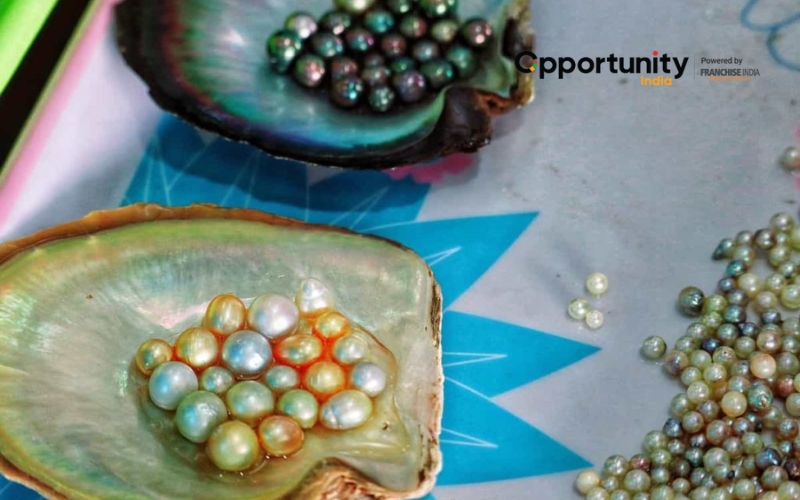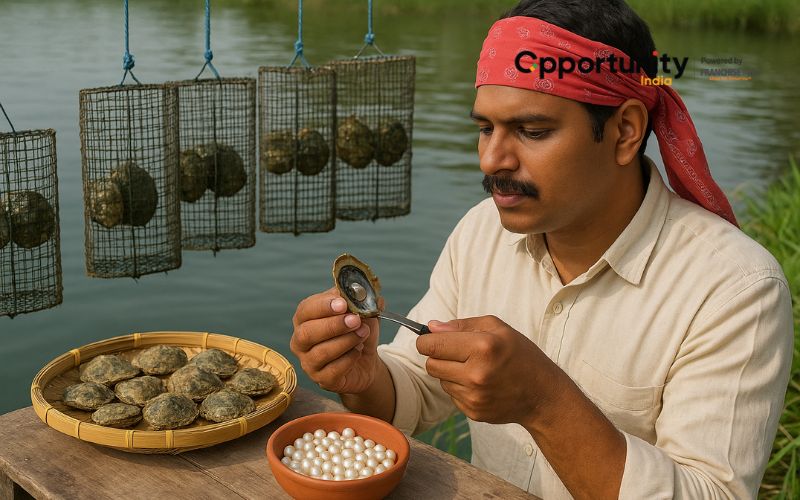
When you saw a stunning pearl necklace, did you ever ask yourself, "How are these shiny little treasures made?" You're not alone! Many people are unaware that pearls are now produced in India rather than being picked from the ocean. And you know what? For Indian farmers, pearl farming has emerged as one of the most profitable and sustainable agricultural ventures. Whether you're a farmer seeking to expand your business, an entrepreneur interested in aquaculture, or simply a pearl enthusiast, this article is for you!
What is Pearl Farming?
Pearl farming, sometimes referred to as pearl cultivation, is the technique of artificially causing mollusks, mostly oysters, to produce pearls by introducing an irritant or nucleus into their shell. Around the nucleus, the mollusk secretes nacre, a calcium carbonate material that eventually forms a pearl. Freshwater pearl production is more prevalent in India since freshwater mussel-friendly tanks, ponds, and rivers are easily accessible.
Also Read: How to Make a Profitable Hydroponic Farming Business Plan?
Due to rising demand for genuine pearls and a lower initial investment than other aquaculture ventures, pearl farming—once thought of as an exotic endeavor—has become an attractive agribusiness in India. For farmers, particularly those with access to freshwater resources, pearl farming presents a significant revenue possibility with the right management and approach.
With its long coastline and wide-ranging freshwater ecosystem, India has enormous potential for pearl cultivation, or "perliculture." A once-luxury mostly connected to natural pearls found in a small number of marine beds, cultured pearl farming has become an economic aquaculture endeavor that offers substantial returns with comparatively little initial investment and government assistance.
Why Pearl Farming in India?
Pearl farming is a very profitable industry due to the rising demand for pearls in a variety of industries, including jewelry, fashion, cosmetics, and traditional medicine. India's hospitable environment, plentiful water supplies, and rising standard of living all contribute to this demand. Some of the main benefits are:
- High Market Value: Pearls that are grown, especially those of high grade, fetch exceptionally high prices. Saltwater pearls can command higher prices than freshwater pearls, which are typically less expensive. There is a significant demand for designer pearls with distinctive forms and patterns.
- Government Support: Through programs like the Blue Revolution Scheme and the Pradhan Mantri Matsya Sampada Yojana (PMMSY), the Indian government actively encourages pearl production. These programs frequently include funding for market connections, training, and unit setup.
- Longevity and Storage Ease: Pearls don't spoil when stored for an extended period, which lowers post-harvest losses.
- Minimal Labor & Inputs: After the initial setup and grafting are finished, pearl farming can be operated with a lot less labor than many other agricultural or aquaculture techniques.
- Dual Farming Opportunities: Pearl farming can be combined with already-existing fish farming operations to maximize the use of water resources and boost production.
- Eco-friendly Business: Growing pearls is generally seen as an environmentally friendly activity.

Types of Pearls Cultivated in India
In India, two main varieties of pearls are grown:
- Freshwater Pearls: These are grown in tanks, ponds, and rivers. Parreysia corrugata, Lamellidens marginalis, and L. corrianus are the mussels that are most frequently used. Since a single freshwater mussel can yield 10–20 pearls, it is a profitable endeavor.
- Saltwater (Marine) Pearls: Usually made from pearl oysters (Pinctada species), these pearls are grown in brackish or oceanic water. Due to their exceptional shine and roundness, these pearls typically fetch greater premiums. Marine pearl oyster populations are being improved by hatchery production and ranching.
- Mabe Pearls: These are hemispherical pearls that are grown inside the shell of mollusks. Additionally, brackish or marine water is used to cultivate them.
Also Read: Aloe Vera Farming in India: A Business Plan
The Pearl Farming Process: A Step-by-Step Guide
The process of pearl farming, which usually takes 12 to 24 months, requires a delicate balancing act between patience and science. This is a thorough explanation of the procedure:
Training and Understanding Acquisition
It is essential to have appropriate training and theoretical understanding before starting a pearl farm. The Central Marine Fisheries Research Institute (CMFRI) and the ICAR-Central Institute of Freshwater Aquaculture (CIFA) in Bhubaneswar are two organizations that provide thorough training courses in freshwater and marine pearl farming methods. Water quality control, disease prevention, mollusk handling, and grafting techniques are all covered in this training.
Water Body and Site Selection
Pick a pond that is free of pollutants or build a cement tank. Make sure it is accessible for routine care and observation. Ideally, the chosen location should be:
- Pollution-Free: The quality of the water is vital. Stay away from places where there is a lot of agricultural discharge or industrial runoff.
- Adequate Water Source: A pond, lake, or man-made tank with pure, well-oxygenated water is necessary for freshwater farming. Coastal regions with adequate water flow and salinity are required for marine farming.
- Ideal Water Conditions: Generally speaking, mussels prefer water with a pH of 7 to 8.5 and a temperature between 25°C and 30°C. It is crucial to do routine water quality testing (for example, at labs recognized by CIFA).
- Size and Depth: A pond that is at least 10 m by 10 m is advised for a small-scale freshwater farm. For convenient water replacement, the tank's base should slope.
Mollusc Procurement/Collection
- Freshwater Mussels: You can buy freshwater mussels from authorized hatcheries or gather them from ponds and rivers. For higher-quality pearls, healthy mussels that are at least two years old (length ≥ 8 cm, weight ≥ 35g) are ideal.
- Marine Oysters: Mature oysters can be bought from reputable suppliers, or spat (larvae) can be harvested.
Pre-operative Conditioning (Acclimatization)
After being gathered, mollusks undergo a 10- to 15-day pre-operative conditioning phase (also known as acclimatization). They are housed in cramped tanks with stale tap water. The implantation process is facilitated by this crowding, which relaxes the adductor muscles.
Also Read: How to Start Organic Farming: Profitable Business Plan?
Surgical Implantation (Grafting)
The most important step is this:
- A mantle tissue from a donor mussel and a nucleus, often formed from shell beads, are surgically placed within the mussel's gonad.
- Using specialist instruments, this procedure is carried out in a sterile environment.
- This should only be done by qualified experts or individuals who have received training at organizations like CIFA.
Post-operative Care
For two to three days following implantation, the mollusks are housed in a different, smaller tank for observation and recuperation. Infections can be avoided by administering antibiotic medication.
Pond Culture
The mussels are moved to the pond and suspended using cages or nylon bags fastened to bamboo rafts once they have recovered. There are 10 to 15 mussels in each cage. It is necessary to regularly check the water quality, cleanliness, and algae growth.
Maintenance and Observation
To encourage the natural availability of food, feed mussels plankton-rich water, cow dung slurry, or organic manure. Look for dead mussels and get rid of them as away to prevent contamination.

Harvesting and Marketing
Pearls can be harvested once the cultivation phase (12–24 months) is over. The pearls are carefully removed from mollusks without causing any harm. After being harvested, the pearls are cleaned, sorted for sale, and graded according to size, shape, color, luster, and surface quality.
You can sell pearls to:
- Jewelers and jewelry manufacturers
- Cosmetic companies (pearl powder)
- Ayurvedic and pharmaceutical companies
- Export agencies
- Online marketplaces and direct consumers
Investment Cost in Pearl Farming (Per 1000 Mussels)
| Particulars | Estimated Cost (INR) |
|---|---|
| Mussels (1000 nos. @ ₹10 each) | ₹10,000 |
| Surgical tools and equipment | ₹25,000 |
| Training (optional) | ₹10,000 |
| Nucleus beads and mantle tissue | ₹5,000 |
| Cage/raft construction | ₹15,000 |
| Pond cleaning and preparation | ₹5,000 |
| Feed and maintenance (18 months) | ₹10,000 |
| Miscellaneous and labour charges | ₹10,000 |
| Total Estimated Investment | ₹90,000 |
Case Studies and Success Stories
Pearl farming has become a profitable side business for many farmers in areas like Uttar Pradesh, Odisha, and Bihar. Some have even expanded their operations by providing surgical instruments, mussels, and teaching others.
Narendra Kumar Girwa, a bookseller, transformed his life with his accidental discovery of pearl farming videos. With fresh knowledge and a strong will, Narendra entered the pearl growing industry in 2015. After acquiring 500 mussels from Kerala, he began growing freshwater pearls in the village. With his determination, he generates 5000 pearls per cycle and earns Rs 10–16 lakhs annually.
Also Read: How To Start a Fish Farming Business With a Plan in India?
Wrapping Up
With constant determination and careful research, you can also build a successful pearl farming business. If handled carefully and skillfully, pearl farming may be a very profitable, environmentally responsible, and sustainable endeavor. The market need is continuously rising, and the initial expenditure is minimal in comparison to the possible returns.
Pearl farming might be your next big business if you're an agribusiness owner, farmer, or someone with access to a body of water and a love for aquaculture.

